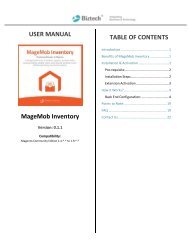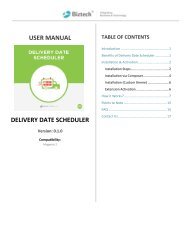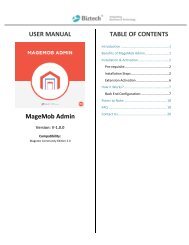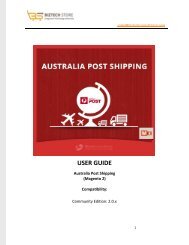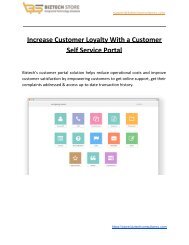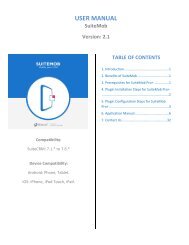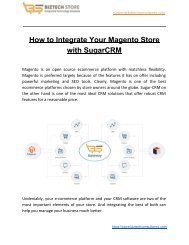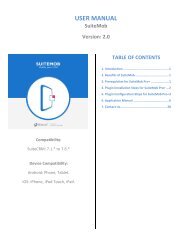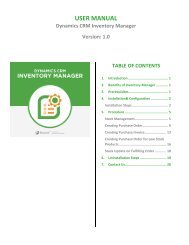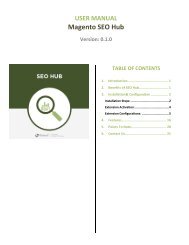7 Ecommerce Inventory Management Best Practices You Should Follow
7 best practices to take care of inventory management for your online store. Follow these to setup a smooth supply chain for your ecommerce business. Get a robust inventory management software for your online store that helps you manage purchases, stocks, documentation, stock keeping, etc and automated routine tasks like generation of purchase orders and invoices.
7 best practices to take care of inventory management for your online store. Follow these to setup a smooth supply chain for your ecommerce business. Get a robust inventory management software for your online store that helps you manage purchases, stocks, documentation, stock keeping, etc and automated routine tasks like generation of purchase orders and invoices.
You also want an ePaper? Increase the reach of your titles
YUMPU automatically turns print PDFs into web optimized ePapers that Google loves.
support@biztechconsultancy.com<br />
7 <strong>Ecommerce</strong> <strong>Inventory</strong> <strong>Management</strong><br />
<strong>Best</strong> <strong>Practices</strong> <strong>You</strong> <strong>Should</strong> <strong>Follow</strong><br />
For an ecommerce business to succeed amidst the increasing competition, there<br />
are a few central things which should be managed proficiently. Among these,<br />
proper <strong>Inventory</strong> management is vital to the smooth running of a business.<br />
Choosing the products you want to sell, and setting up a proper business model<br />
to source products and a way to make them available to customers is an<br />
important part of any business.<br />
But how do you manage your inventory? What are the aspects you should take<br />
care of? Not every business owner is an efficient supply chain expert and hence,<br />
need guidance on the same. The first step in the right direction in this regard<br />
would be to get a robust inventory management software for your online store<br />
https://store.biztechconsultancy.com
support@biztechconsultancy.com<br />
that helps you manage purchases, stocks, documentation, stock keeping, etc<br />
and automated routine tasks like generation of purchase orders and invoices.<br />
But even to get the best out of any software you should know how inventory<br />
management is done. Here’s a list of 7 ecommerce inventory management best<br />
practices that will get you started.<br />
1. Priority Stock Up<br />
To ensure that your best selling items are never going out of stock, you should<br />
regularly check that they are enough in stock to ship to the next customer.<br />
Going ‘out of stock’ for the popular products on your site can be destructive for<br />
your business. Other products which might be seasonal or shows one or two<br />
sales now and then can take this for once, but high priority merchandise should<br />
be reordered immediately after the product is ordered by a customer (not<br />
waiting for the actual shipment process.<br />
2. Drop Shipping<br />
Drop shipping almost means that you never run out of stock without even<br />
having a physical inventory. What merchants do is take up the order and engage<br />
drop shippers to pick up the product from the supplier, pack it, and send it to<br />
the customer. The customer needs not to know if any third party had been<br />
engaged in the transaction. This also doesn’t come to be hassle- free. <strong>You</strong> need<br />
to continuously sync in with the shipper for updates regarding inventory, order,<br />
and delivery. <strong>You</strong> can then convey the order status to the customer. But it’s<br />
worth the effort. It also allows you to offer a huge array of products to your<br />
customers and enhances customer satisfaction.<br />
3. Immediate <strong>Inventory</strong> Updates<br />
<strong>You</strong> should keep a close check on your inventory. As soon as a product is sold,<br />
you should get the space refilled immediately. Don’t postpone it to a certain<br />
time after sales, your next order could be in another half an hour, so keep<br />
yourself geared up for that by having immediate updates and take quick actions<br />
by sourcing that product at the earliest. If you fail to do so, it’s not good for your<br />
businesses revenue sheets. If your site shows a certain product is in stock and<br />
https://store.biztechconsultancy.com
support@biztechconsultancy.com<br />
the customer is later informed about the unavailability, you might lose the<br />
customer for life.<br />
4. Cross-Platform <strong>Inventory</strong> <strong>Management</strong><br />
If you are selling across platforms, you need to be more vigilant with your<br />
inventory. For separate channels, manage different warehouses and inventory<br />
records or you might end up messing it. If a product is out of stock and any of<br />
the channels fail to update it, a customer might order the product and you are<br />
left with no option but to inform them later that it’s out of stock. Therefore, you<br />
must make it a point to handle all channels efficiently. <strong>You</strong> can also take help<br />
from ecommerce inventory management software which helps you integrate<br />
the channels and manage the inventory.<br />
5. Managing Variety of Products<br />
Stocking up your inventory timely gets more difficult when you are dealing in<br />
variant products. It can be easy to stock up items like books or kitchen<br />
accessories, but the same goes complicated when you are dealing in apparels<br />
and footwear. That’s because you don’t just need to refill a particular design or<br />
color for apparels or similar items, but different sizes as well. A proper and full<br />
inventory means having all the sizes, in all designs and colors ready at any<br />
moment. So, if you are dealing in businesses like these, it would be difficult to<br />
keep a check through the e-commerce platform and will need a proper<br />
inventory management solution to ensure that your stock is updated.<br />
6. Kits and Combos<br />
When you are offering products as individual items and as a part of combination<br />
sets as well, you need to keep a check on these products. If any of these<br />
products go out of stock individually and you don’t take heed, you might not be<br />
able to ship the kit/combo on time and that’s definitely not good for your<br />
business. <strong>You</strong> can also engage in partnership with a third party to manage<br />
responsibility for collecting the combination products from different sellers,<br />
pack it, and ship it. <strong>You</strong>r inventory remains intact and your customer satisfied.<br />
https://store.biztechconsultancy.com
support@biztechconsultancy.com<br />
7. Calculate Re-Stocking Time<br />
Managing an ecommerce store means sourcing products or raw materials from<br />
different sellers and further putting them up on sale. When you are sourcing<br />
products from different sellers, you should know in advance of the time they will<br />
take to send out certain products. Note that they are actually re stocking the<br />
items within that time period. Synchronization with your sellers is as much<br />
important. When you know how much time is required for you to get a product,<br />
you can plan to restock your inventory accordingly. If you are ordering raw<br />
materials, you need to speed up a bit as it takes time to get the final product<br />
that is to be shipped to the customer. So, calculate the average time it takes to<br />
restock a product and plan accordingly.<br />
Conclusion<br />
Though it is true that it’s not easy to run a hassle-free business, but it is certainly<br />
not impossible. If you align your strategies properly with the day to day activities<br />
of your business, the sail will be much smoother. If you once get a formula<br />
which works fine for the kind of products you deal in, your inventory would get<br />
much easier to manage. But as no particular thing fits for all, you need to come<br />
to that stage where you have discovered it yourself. Once you know how buying<br />
and selling goes swiftly for your e-commerce, you can follow it to grow your<br />
business further and generate more sales and revenue.<br />
Resources:<br />
https://store.biztechconsultancy.com/blog/ecommerce-inventory-man<br />
agement-best-practices/<br />
Reference :<br />
● https://store.biztechconsultancy.com/magento-mobile-inventory.htm<br />
● https://store.biztechconsultancy.com/magento-mob-admin.htm<br />
● https://store.biztechconsultancy.com/magento-mobile-pos.htm<br />
https://store.biztechconsultancy.com
support@biztechconsultancy.com<br />
https://store.biztechconsultancy.com



